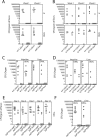A MyD88-deficient mouse model reveals a role for Nramp1 in Campylobacter jejuni infection
- PMID: 17194808
- PMCID: PMC1865720
- DOI: 10.1128/IAI.01216-06
A MyD88-deficient mouse model reveals a role for Nramp1 in Campylobacter jejuni infection
Abstract
Campylobacter jejuni is a major worldwide cause of enteric illnesses. Adult immunocompetent mice are not susceptible to C. jejuni infection. However, we show here that mice deficient in the adaptor protein myeloid differentiation factor 88 (MyD88), which is required for signaling through most Toll-like receptors, can be stably colonized by C. jejuni but not by isogenic derivatives carrying mutations in known virulence genes. We also found that Nramp1 deficiency increases the mouse susceptibility to C. jejuni infection when administered systemically. These results indicate that MyD88-deficient mice could be a useful model to study C. jejuni colonization and reveal a potential role for Nramp1 in the control of this bacterial pathogen.
Figures









Similar articles
-
Intestinal colonization of rats following experimental infection with Campylobacter jejuni.East Afr Med J. 1991 May;68(5):348-51. East Afr Med J. 1991. PMID: 1935728
-
A murine intraperitoneal infection model reveals that host resistance to Campylobacter jejuni is Nramp1 dependent.Microbes Infect. 2008 Jul;10(8):922-7. doi: 10.1016/j.micinf.2008.05.001. Epub 2008 May 14. Microbes Infect. 2008. PMID: 18656410
-
Influence of Campylobacter jejuni fliA, rpoN and flgK genes on colonization of the chicken gut.Int J Food Microbiol. 2007 Sep 15;118(2):194-200. doi: 10.1016/j.ijfoodmicro.2007.07.038. Epub 2007 Aug 1. Int J Food Microbiol. 2007. PMID: 17761334
-
The immunobiology of Campylobacter jejuni: Innate immunity and autoimmune diseases.Immunobiology. 2016 Apr;221(4):535-43. doi: 10.1016/j.imbio.2015.12.005. Epub 2015 Dec 8. Immunobiology. 2016. PMID: 26709064 Review.
-
Insights into Campylobacter jejuni colonization of the mammalian intestinal tract using a novel mouse model of infection.Gut Microbes. 2015;6(2):143-8. doi: 10.1080/19490976.2015.1016691. Epub 2015 Apr 1. Gut Microbes. 2015. PMID: 25831043 Free PMC article. Review.
Cited by
-
Metabolic and fitness determinants for in vitro growth and intestinal colonization of the bacterial pathogen Campylobacter jejuni.PLoS Biol. 2017 May 19;15(5):e2001390. doi: 10.1371/journal.pbio.2001390. eCollection 2017 May. PLoS Biol. 2017. PMID: 28542173 Free PMC article.
-
Campylobacter jejuni survives within epithelial cells by avoiding delivery to lysosomes.PLoS Pathog. 2008 Jan;4(1):e14. doi: 10.1371/journal.ppat.0040014. PLoS Pathog. 2008. PMID: 18225954 Free PMC article.
-
A novel mouse model of Campylobacter jejuni gastroenteritis reveals key pro-inflammatory and tissue protective roles for Toll-like receptor signaling during infection.PLoS Pathog. 2014 Jul 17;10(7):e1004264. doi: 10.1371/journal.ppat.1004264. eCollection 2014 Jul. PLoS Pathog. 2014. PMID: 25033044 Free PMC article.
-
Transmigration route of Campylobacter jejuni across polarized intestinal epithelial cells: paracellular, transcellular or both?Cell Commun Signal. 2013 Sep 30;11:72. doi: 10.1186/1478-811X-11-72. Cell Commun Signal. 2013. PMID: 24079544 Free PMC article. Review.
-
Sexual dimorphism in campylobacteriosis.Epidemiol Infect. 2008 Nov;136(11):1492-5. doi: 10.1017/S0950268807009934. Epub 2007 Dec 7. Epidemiol Infect. 2008. PMID: 18062834 Free PMC article.
References
-
- Adachi, O., T. Kawai, K. Takeda, M. Matsumoto, H. Tsutsui, M. Sakagami, K. Nakanishi, and S. Akira. 1998. Targeted disruption of the MyD88 gene results in loss of IL-1- and IL-18-mediated function. Immunity 9:143-150. - PubMed
-
- Akira, S., K. Takeda, and T. Kaisho. 2001. Toll-like receptors: critical proteins linking innate and acquired immunity. Nat. Immunol. 2:675-680. - PubMed
-
- Allos, B. M. 2001. Campylobacter jejuni infections: update on emerging issues and trends. Clin. Infect. Dis. 32:1201-1206. - PubMed
-
- Bacon, D. J., C. M. Szymanski, D. H. Burr, R. P. Silver, R. A. Alm, and P. Guerry. 2001. A phase-variable capsule is involved in virulence of Campylobacter jejuni 81-176. Mol. Microbiol. 40:769-777. - PubMed
Publication types
MeSH terms
Substances
LinkOut - more resources
Full Text Sources
Medical
Molecular Biology Databases

